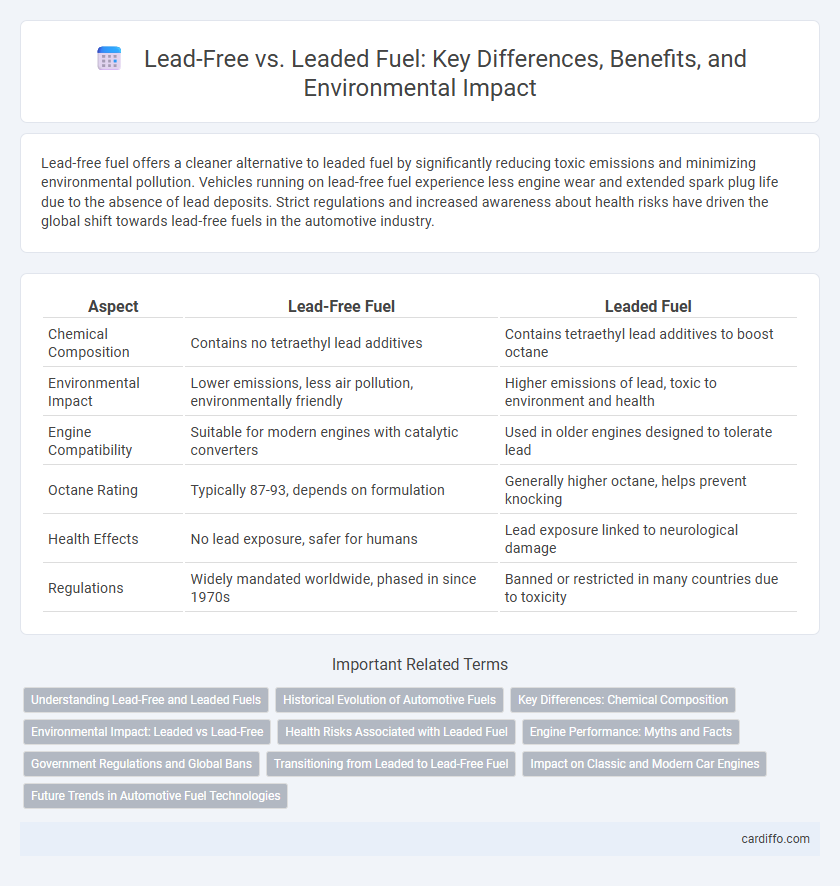Lead-free fuel offers a cleaner alternative to leaded fuel by significantly reducing toxic emissions and minimizing environmental pollution. Vehicles running on lead-free fuel experience less engine wear and extended spark plug life due to the absence of lead deposits. Strict regulations and increased awareness about health risks have driven the global shift towards lead-free fuels in the automotive industry.
Table of Comparison
| Aspect | Lead-Free Fuel | Leaded Fuel |
|---|---|---|
| Chemical Composition | Contains no tetraethyl lead additives | Contains tetraethyl lead additives to boost octane |
| Environmental Impact | Lower emissions, less air pollution, environmentally friendly | Higher emissions of lead, toxic to environment and health |
| Engine Compatibility | Suitable for modern engines with catalytic converters | Used in older engines designed to tolerate lead |
| Octane Rating | Typically 87-93, depends on formulation | Generally higher octane, helps prevent knocking |
| Health Effects | No lead exposure, safer for humans | Lead exposure linked to neurological damage |
| Regulations | Widely mandated worldwide, phased in since 1970s | Banned or restricted in many countries due to toxicity |
Understanding Lead-Free and Leaded Fuels
Lead-free fuels, commonly known as unleaded gasoline, contain no tetraethyl lead additives, reducing harmful emissions and engine deposits. Leaded fuels include tetraethyl lead, historically used to improve octane ratings but linked to environmental pollution and health risks. Understanding the differences between leaded and lead-free fuels is crucial for modern engine compatibility and regulatory compliance.
Historical Evolution of Automotive Fuels
The historical evolution of automotive fuels highlights the transition from leaded to lead-free gasoline due to environmental and health concerns associated with tetraethyl lead additives. Leaded fuels, widely used from the 1920s to the 1970s, improved engine performance but caused air pollution and lead poisoning risks. The global phase-out of leaded gasoline began in the late 20th century, leading to the adoption of unleaded fuels and catalytic converters that significantly reduced toxic emissions.
Key Differences: Chemical Composition
Lead-free fuel contains hydrocarbons without tetraethyl lead additives, reducing toxic emissions and environmental harm. Leaded fuel incorporates tetraethyl lead as an anti-knock agent, enhancing octane ratings but releasing harmful lead particles upon combustion. The absence of lead compounds in unleaded fuel improves engine performance in modern vehicles and complies with stringent emission regulations worldwide.
Environmental Impact: Leaded vs Lead-Free
Lead-free fuel significantly reduces environmental contamination by eliminating lead emissions, which are toxic to both ecosystems and human health. Leaded fuel releases airborne lead particles that accumulate in soil and water, causing long-term environmental damage and bioaccumulation in wildlife. Switching to lead-free fuel decreases air pollution, enhances public health, and supports sustainable environmental practices.
Health Risks Associated with Leaded Fuel
Leaded fuel releases toxic lead particles into the air, which can cause severe health issues including neurological damage, cognitive impairments, and cardiovascular problems. Prolonged exposure to lead emissions is linked to developmental delays in children and increased risks of respiratory diseases. Switching to lead-free fuel significantly reduces these health risks by preventing lead contamination in the environment.
Engine Performance: Myths and Facts
Lead-free fuel provides cleaner combustion, reducing engine deposits and enhancing long-term performance, while leaded fuel, historically used to prevent valve seat wear, is largely obsolete due to advancements in engine materials. Contrary to myths, modern engines designed for unleaded fuel achieve optimal power and efficiency without the anti-knock benefits of lead. Scientific studies confirm that lead additives degrade catalytic converters and increase pollution, negating any performance advantages in contemporary vehicles.
Government Regulations and Global Bans
Government regulations have increasingly mandated the phase-out of leaded fuel due to its severe public health and environmental impacts, with the United Nations Environment Programme reporting that as of 2021, leaded gasoline use has been banned in more than 180 countries worldwide. Global bans on leaded fuel have resulted in significant declines in atmospheric lead levels and associated health risks, prompting ongoing efforts to enforce strict emissions standards and promote lead-free alternatives. Enforcement agencies continue to update policies to ensure compliance, emphasizing the transition toward unleaded fuels to support sustainable and safe transportation systems globally.
Transitioning from Leaded to Lead-Free Fuel
Transitioning from leaded to lead-free fuel significantly reduces harmful emissions, improving air quality and public health by eliminating lead pollution. Lead-free fuel supports advanced engine technologies and catalytic converters, enhancing vehicle performance and fuel efficiency. Regulatory policies worldwide have accelerated this shift, driving adoption of unleaded gasoline in automotive markets.
Impact on Classic and Modern Car Engines
Lead-free fuel is essential for modern car engines designed with catalytic converters, as it prevents damage to emission control systems and maintains optimal engine performance. Classic cars originally engineered for leaded gasoline often require lead substitutes or additives to protect valve seats from wear and maintain engine integrity. Using the incorrect fuel type can lead to increased engine wear, reduced efficiency, and costly repairs in both classic and modern vehicles.
Future Trends in Automotive Fuel Technologies
The automotive industry is rapidly shifting towards lead-free fuels due to stringent environmental regulations and advancements in catalytic converter technologies that require unleaded gasoline for optimal performance. Future fuel trends emphasize biofuels, electric powertrains, and synthetic fuels designed to reduce emissions and improve sustainability, making leaded fuel obsolete. Innovations in fuel additives and engine design further support the transition to cleaner, lead-free options that align with global goals for carbon neutrality and air quality improvement.
Lead-Free vs Leaded Infographic

 cardiffo.com
cardiffo.com